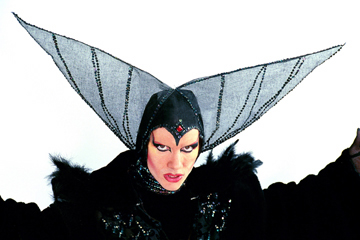A Tasteless Beauty
Sleeping
Beauty
Saba Dance Theatre
(presented by French Institute Alliance Francaise)
Florence Gould Hall
New York, NY
November 15, 2003
By
Susan Reiter
copyright © 2003 by Susan Reiter
What are all these children making of all this? I found myself wondering as this stupefyingly tasteless and amateurish vanity project unfolded in front of what was largely a family audience. The Alliance Francaise's dance offerings are sporadic, and in the past have featured some respected and adventurous contemporary French troupes. What led them to present the Saba Dance Theatre—named for its artistic director/choreographer/costume designer, the single-named (like Cher, with whom he shares a penchant for extravagant, tasteless get-ups) Saba, is a mystery.
 According
to his bio, the French-born Saba trained and performed under Rosella Hightower,
then came to New York where he studied at the Martha Graham School and
worked with the Graham Ensemble, Pearl Lang and Sophie Maslow.
According
to his bio, the French-born Saba trained and performed under Rosella Hightower,
then came to New York where he studied at the Martha Graham School and
worked with the Graham Ensemble, Pearl Lang and Sophie Maslow.
His take on Sleeping Beauty aims to do for Carabosse what the current Broadway show Wicked does for the Wizard of Oz's Wicked Witch: gives her a backstory, makes her the victim of other people's schemes, and turns her into the heroine. He himself, in various outrageous outfits and headdresses, plays Carabosse, of course. The Queen, a soulless, scheming bitch, is the real baddie in this tale, and Carabosse liberates and empowers Aurore (as the program calls her), helping her to choose her own path.
At times, the characters speak, declaiming their ponderous lines awkwardly. Most of the music is from Tchaikovsky's score, but three of the 15 sections, including a garish club scene (don't ask) are set to music by a French group called NinetyEleven.
As for the dancing—imagine watching the most labored, inept dance school recital, without any of the charm that comes from watching young students sweetly trying their best. Everyone was barefoot, and the simple, mechanical, completely un- (at times anti-) musical steps they performed were too bland to quality as modern dance. Saba used battements and developpés ad infinitum, and threw in hip thrusts, bent-over simian moves and other ungainly, incoherent elements, seemingly at random. He has no sense of theater or ideas about using space, and the action (so to speak) frequently stopped dead in its tracks.
The fairies had lumbering variations during which they posed and stretched into awkward positions, ignoring the propulsive momentum of Tchaikovsky's lovely music. They wore unflattering two-piece outfits, each in her own garish color. They then proceeded stiffly over to the infant princess's cradle and shouted out which gift (love, beauty, strength, etc.) they were bestowing upon her. There was no Lilac fairy—with Carabosse a misunderstood well-intentioned heroine, apparently there was no need for this embodiment of Good—but that didn't stop Saba from using the music for her variation for one of his fairies. Even more weird was his setting the final (endless) "variation" to the Prologue's coda that is usually danced by all the attendants, cavaliers, etc. But this was not the place to look for logic.
A section meant to indicate the passage of time, used the familiar dance convention of figures embodying the four seasons. But these four, attired in black tops and briefs adorned with elaborate decorations and headdresses to indicate the seasons, crossed the stage in clunky, stiff movements that hardly qualified as dancing.
Aurore was a tall, strapping young girl with short hair. When her prince suddenly appears (she has awoken on her own, and there is no indication where he came from or how he found her), he wears a skimpy outfit of shiny mauve material, and looks a lot more feminine than she does.
When Carabosse—now revealed as a mohawk-sporting bare-chested guy in ugly loose orange pants—is interrogated and put to death by crucifixion, the blindly egotistical nature of Saba's venture reached its apogee. Some of his more garishly layered costumes suggest that he may have a future designing for bus-and-truck companies of "Taboo," but he is a choreographer only in his own misguided imagination.
Photo: Saba, by Alexandros Giannakis.
Originally
published:
www.danceviewtimes.com
Volume 1, Number 8
November 17, 2003
Copyright
©2003 by Susan
Reiter
|
|